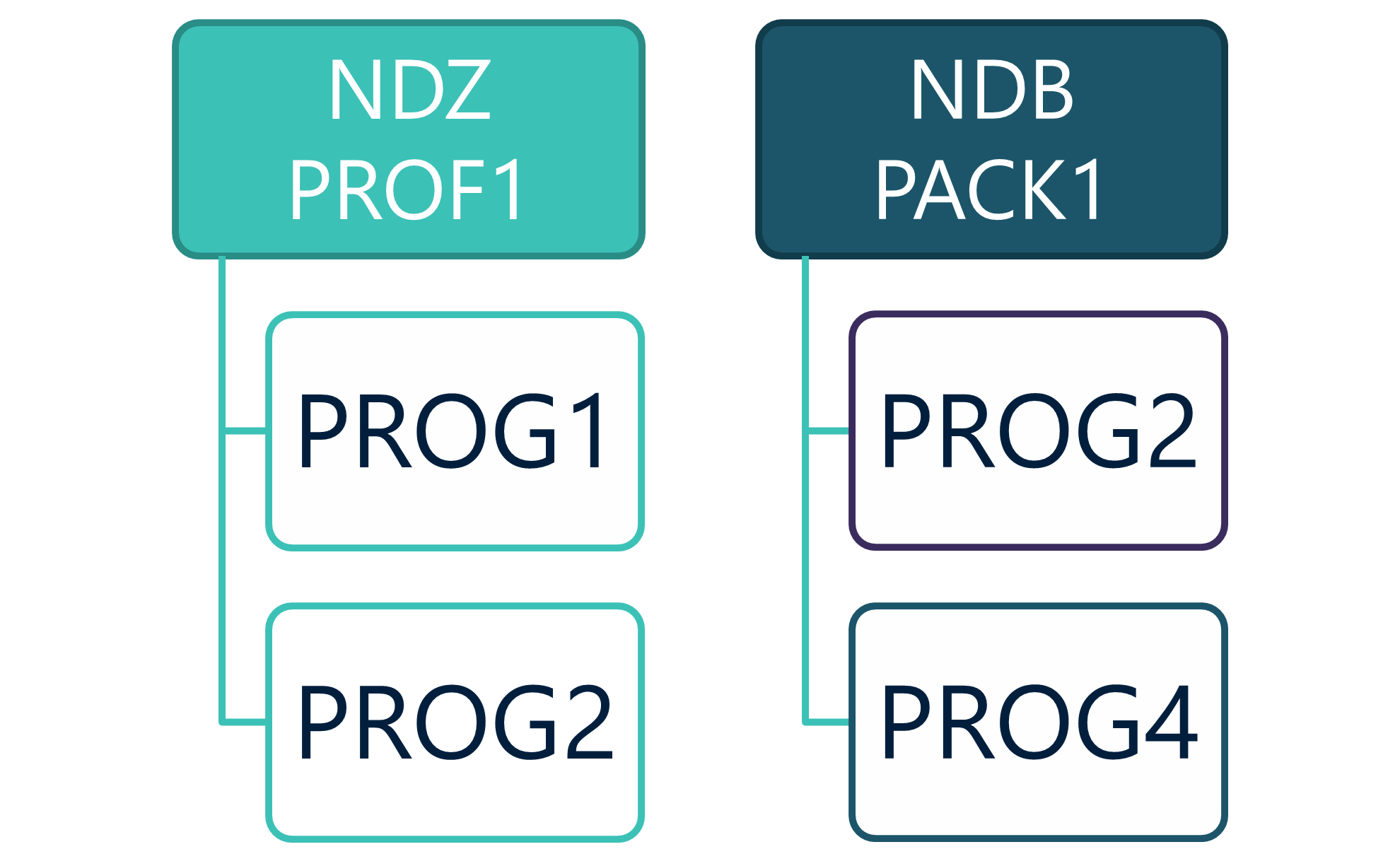The static generation for NDZ is independent from the static generation of NDB. This means that Natural programs can be generated static for NDZ. Their SQL statements are placed in a SQLJ profile, the SQLJ profile name and the SQLJ sequence numbers are stored into Natural objects for static execution, and a package containing the SQL statements is bound in Db2.
Independently from the NDZ static generation, Natural programs can be generated statically for NDB. Their SQL statements are precompiled in an assembler program, the DBRM name and the section and statement numbers are stored into the Natural objects for static execution, and a package containing the SQL statements is bound in Db2.
The Natural programs subject to NDZ static generation and NDB static generation don't have to be identical. However, one Natural program can only be in one SQLJ profile and/or in one NDB DBRM/PACKAGE. The following graphic shows an NDZ static generation done for Natural programs PROG1 and PROG2 contained in the SQLJ profile and package PROF1 and an NDB static generation done for Natural programs PROG2 and PROG4 contained in package PACK1.

The following information describes the steps of the NDZ static generation as delivered in the NDZSTATG job of the installation.
The first step is about Natural Batch and is identical to the first step of the NDB
static generation. The CMD CREATE DBRM command creates an SQL assembler
program. For details look into the NDB documentation, section Generation Procedure: CMD Create
Command.
You must convert the temporary assembler program generated in Step 1 to a SQLJ program.
The Java program com.softwareag.ndz.sqljgen.SQLJGenerator is provided to
perform this conversion. You must use IBM JZOS Batch Launcher to execute this program.
DBRM name – the name of the generated SQLJ program. This name has
to be the same as the one used in Step 1.
INPUT – The temporary assembler program generated in step 1.
OUTPUT – The temporary SQLJ program.
JCL Example:
//GENSQLJ EXEC PROC=JVMPRC86,REGSIZE=1024M,
// JAVACLS='com.softwareag.ndz.sqljgen.SQLJGenerator'
//INPUT DD DSN=&&TMP6,DISP=(OLD,PASS)
//OUTPUT DD PATH='&NDZPATH./static/&PROFILE..sqlj',
// PATHDISP=(KEEP,DELETE),
// PATHOPTS=(OCREAT,ORDWR),
// PATHMODE=(SIRUSR,SIWUSR,
// SIRGRP,SIWGRP,
// SIROTH,SIWOTH),
// FILEDATA=TEXT
//MAINARGS DD *,SYMBOLS=JCLONLY
&PROFILE
//STDENV DD *,SYMBOLS=JCLONLY
. /etc/profile
. &NDZPATH./bin/setenv.sh
/*
Then you must use the IBM Db2 SQLJ Translator (sqlj) to generate an SQLJ profile using
the SQLJ program generated in the previous step as input. You can call the SQLJ translator
with the provided IBM Db2 class sqlj.tools.Sqlj. You must use the IBM JZOS
Batch Launcher to execute this program.
JCL Example:
//GENPROF EXEC PROC=JVMPRC86,REGSIZE=1024M,
// JAVACLS='sqlj.tools.Sqlj'
//MAINARGS DD *,SYMBOLS=JCLONLY
-compile=true -d=&NDZPATH./static
&NDZPATH./static/&PROFILE..sqlj
//STDENV DD *,SYMBOLS=JCLONLY
. /etc/profile
. &NDZPATH./bin/setenv.sh
/*
OR
You can use the provided shell script genprof.sh to complete this step. The
script is located in the bin subdirectory of your NDZ installation.
Usage: genprof <NDZ_PATH> <program>
You must then modify the Natural programs with the SQLJ profile name and the SQLJ
sequence numbers using the CMD
MODIFYZ command. Input the temporary assembler program created
during the first step.
Lastly, use the NDZ SQLJ Profile binder, com.softwareag.ndz.sqljbinder, to
bind packages for the SQLJ Profile generated in the previous step. You must use the IBM
JZOS Batch Launcher to execute this program.
JCL Example:
//BIND EXEC PROC=JVMPRC86,REGSIZE=1024M, // JAVACLS='com.softwareag.ndz.sqljbinder.Main' //MAINARGS DD *,SYMBOLS=JCLONLY -profile &PROFILE -bindoptions &BINDOPTS //STDENV DD *,SYMBOLS=JCLONLY . /etc/profile . &NDZPATH./bin/setenv.sh /*
OR
You can use the provided shell script bind.sh to complete this step.
Usage: bind <NDZ_PATH> <url> <user> <password> <program> <bind_opts>
setenv.sh – Sets the environment variables for Java, Db2, and NDZ. The
variables are required by other scripts.
genprof.sh – Generates profiles for static execution. Syntax:
genprof ndz_path program
Where ndz_path is the NDZ installation path and program is the SQLJ program that is used to generate the profile.
bind.sh – Binds a static profile to Db2.
Syntax:
bind NDZ_PATH url user password program bind_opts
Where ...
NDZ_PATH is the installation path of NDZ.
url is the URL for Db2 access.
user is the username for Db2 access.
password is the password for the selected username for Db2 access.
program is the Natural program that is accessing Db2.
bind_opts is a list of bind options. Every option has to be seperated by a space and carries the same function as Db2 precompile and bind options. For more information, see the BIND PACKAGE command section in the IBM Db2 documentation.
The following table compares the different steps of NDZ static generation and NDB static generation.
| Step # | NDZ Static Generation | NDB Static Generation |
|---|---|---|
| Step 1 | GENERATE – generate temporary SQL assembler program using
CMD CREATE DBRM.
|
GENERATE/GENERATION – generate temporary SQL assembler program
using CMD CREATE DBRM.
|
| Step 2 | GENSQLJ – generate temporary SQLJ program.
|
This step is omitted in NDB Static Generation. |
| Step 3 | GENPROF – generate the SQLJ profile.
|
PC – Db2 precompiles the SQL assembler program.
|
| Step 4 | MODIFYZ – modify the Natural programs with SQLJ profile numbers
and SQLJ sequence numbers using CMD MODIFYZ |
MODIFY – modify Natural programs with DB2 DBRM name and section
and statement numbers using CMD MODIFY |
| Step 5 | BINDSQLJ– place static SQL information into DB2 to BIND PACKAGE.
|
BIND– place static SQL information into DB2 to BIND
PACKAGE.
|